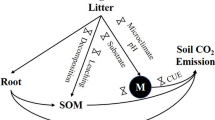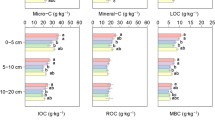Abstract
The contribution of the organic (O) horizon to total soil respiration is poorly understood even though it can represent a large source of uncertainty due to seasonal changes in microclimate and O horizon properties due to plant phenology. Our objectives were to partition the CO2 effluxes of litter layer and mineral soil from total soil respiration (SR) and determine the relative importance of changing temperature and moisture mediating the fluxes. We measured respiration in an oak-dominated forest with or without the O horizon for 1 year within the Oak Openings Region of northwest Ohio. Mineral soil and O horizon respiration were subtracted from mineral soil respiration (MSR) to estimate litter respiration (LR). Measurements were grouped by oak phenology to correlate changes in plant activity with respiration. The presence of the O horizon represented a large source of seasonal variation in SR. The timing of oak phenology explained some of the large changes in both SR and LR, and their relationship with temperature and moisture. The contribution to SR of respiration from the mineral soil was greatest during pre-growth and pre-dormancy, as evident by the low LR:MSR ratios of 0.65 ± 0.10 (mean ± SE) and 0.69 ± 0.03, respectively, as compared to the other phenophases. Including moisture increased our ability to predict MSR and SR during the growth phenophase and LR for every phenophase. Temperature and moisture explained 85% of the variation in MSR, but only 60% of the variation in LR. The annual contribution of O horizon to SR was 48% and the ratio of litter to soil respiration was tightly coupled over a wide range of environmental conditions. Our results suggest the presence of the O horizon is a major mediator of SR.



Similar content being viewed by others
References
Boone RD, Nadelhoffer KJ, Canary JD, Kaye JP (1998) Roots exert a strong influence on the temperature sensitivity of soil respiration. Nature 396:570–572. doi:10.1038/25119
Borken W, Davidson EA, Savage K, Gaudinski J, Trumbore SE (2003) Drying and wetting effects on carbon dioxide release from organic horizons. Soil Sci Soc Am J 67:1888–1896
Brewer LG, Vankat JL (2004) Description of vegetation of the Oak Openings of northwestern Ohio at the time of Euro-American settlement. Ohio J Sci 104:76–85
Brooks PD, McKnight D, Elder K (2005) Carbon limitation of soil respiration under winter snowpacks: potential feedbacks between growing season and winter carbon fluxes. Glob Change Biol 11:231–238. doi:10.1111/j.1365-2486.2004.00877.x
Chen JQ, Saunders SC, Crow TR, Naiman RJ, Brosofske KD, Mroz GD, Brookshire BL, Franklin JF (1999) Microclimate in forest ecosystem and landscape ecology—variations in local climate can be used to monitor and compare the effects of different management regimes. Bioscience 49:288–297. doi:10.2307/1313612
Chen J, Brosofske KD, Noormets A, Crow TR, Bresee MK, Le Moine JM, Euskirchen ES, Mather SV, Zheng D (2004) A working framework for quantifying carbon sequestration in disturbed land mosaics. Environ Manage 33:S210–S221. doi:10.1007/s00267-003-9131-4
Davidson EA, Belk E, Boone RD (1998) Soil water content and temperature as independent or confounded factors controlling soil respiration in a temperate mixed hardwood forest. Glob Change Biol 4:217–227. doi:10.1046/j.1365-2486.1998.00128.x
DeForest JL, Noormets A, McNulty SG, Sun G, Tenney G, Chen JQ (2006) Phenophases alter the soil respiration-temperature relationship in an oak-dominated forest. Int J Biometeorol 51:135–144. doi:10.1007/s00484-006-0046-7
Granier A, Ceschia E, Damesin C, Dufrene E, Epron D, Gross P, Lebaube S, Le Dantec V, Le Goff N, Lemoine D, Lucot E, Ottorini JM, Pontailler JY, Saugier B (2000) The carbon balance of a young beech forest. Funct Ecol 14:312–325. doi:10.1046/j.1365-2435.2000.00434.x
Hanson PJ, Wullschleger SD, Bohlman SA, Todd DE (1993) Seasonal and topographic patterns of forest floor CO2 efflux from an upland oak forest. Tree Physiol 13:1–15
Hanson PJ, Edwards NT, Garten CT, Andrews JA (2000) Separating root and soil microbial contributions to soil respiration: A review of methods and observations. Biogeochemistry 48:115–146. doi:10.1023/A:1006244819642
Hanson PJ, O’Neill EG, Chambers MLS, Riggs JS, Joslin JD, Wolfe MH (2003) Soil respiration and litter decomposition. In: Hanson PJ, Wullschleger SD (eds) North American temperate deciduous forest responses to changing precipitation regimes. Springer, New York, pp 163–189
Hanson PJ, Amthor JS, Wullschleger SD, Wilson KB, Grant RE, Hartley A, Hui D, Hunt ER, Johnson DW, Kimball JS, King AW, Luo Y, McNulty SG, Sun G, Thornton PE, Wang S, Williams M, Baldocchi DD, Cushman RM (2004) Oak forest carbon and water simulations: model intercomparisons and evaluations against independent data. Ecol Monogr 74:443–489. doi:10.1890/03-4049
Janssens IA, Pilegaard K (2003) Large seasonal changes in Q(10) of soil respiration in a beech forest. Glob Change Biol 9:911–918. doi:10.1046/j.1365-2486.2003.00636.x
Law BE, Falge E, Gu L, Baldocchi DD, Bakwin P, Berbigier P, Davis K, Dolman AJ, Falk M, Fuentes JD, Goldstein A, Granier A, Grelle A, Hollinger D, Janssens IA, Jarvis P, Jensen NO, Katul G, Mahli Y, Matteucci G, Meyers T, Monson R, Munger W, Oechel W, Olson R, Pilegaard K, Paw KT, Thorgeirsson H, Valentini R, Verma S, Vesala T, Wilson K, Wofsy S (2002) Environmental controls over carbon dioxide and water vapor exchange of terrestrial vegetation. Agric For Meteorol 113:97–120. doi:10.1016/S0168-1923(02)00104-1
Lee MS, Nakane K, Nakatsubo T, Koizumi H (2003) Seasonal changes in the contribution of root respiration to total soil respiration in a cool-temperate deciduous forest. Plant Soil 255:311–318. doi:10.1023/A:1026192607512
Lloyd J, Taylor JA (1994) On the Temperature-Dependence of Soil Respiration. Funct Ecol 8:315–323. doi:10.2307/2389824
Ma CJ, Tohno S, Kasahara M (2005) A case study of the size-resolved individual particles collected at a ground-based site on the west coast of Japan during an Asian dust storm event. Atmos Environ 39:739–747
Moseley E (1928) Flora Oak Openings Ohio. Acad Sci 20:79–134
Noormets A, McNulty SG, DeForest JL, Sun G, Li Q, Chen J (2008) Drought during canopy development has lasting effect on annual carbon balance in a deciduous temperate forest. New Phytol 179:818–828. doi:10.1111/j.1469-8137.2008.02501.x
Sanderman J, Amundson RG, Baldocchi DD (2003) Application of eddy covariance measurements to the temperature dependence of soil organic matter mean residence time. Global Biogeochem Cycles 17:15. doi:10.1029/2001GB001833
Schimel DS (1995) Terrestrial ecosystems and the carbon-cycle. Glob Change Biol 1:77–91. doi:10.1111/j.1365-2486.1995.tb00008.x
Sulzman EW, Brant JB, Bowden RD, Lajtha K (2005) Contribution of aboveground litter, belowground litter, and rhizosphere respiration to total soil CO2 efflux in an old growth coniferous forest. Biogeochemistry 73:231–256. doi:10.1007/s10533-004-7314-6
Tang JW, Baldocchi DD, Xu L (2005) Tree photosynthesis modulates soil respiration on a diurnal time scale. Glob Change Biol 11:1298–1304. doi:10.1111/j.1365-2486.2005.00978.x
Uchida M, Mo W, Nakatsubo T, Tsuchiya Y, Horikoshi T, Koizumi H (2005) Microbial activity and litter decomposition under snow cover in a cool-temperate broad-leaved deciduous forest. Agric For Meteorol 134:102–109. doi:10.1016/j.agrformet.2005.11.003
Yuste JC, Janssens IA, Carrara A, Ceulemans R (2004) Annual Q(10) of soil respiration reflects plant phenological patterns as well as temperature sensitivity. Glob Change Biol 10:161–169. doi:10.1111/j.1529-8817.2003.00727.x
Acknowledgments
The Southern Global Change Program of the USDA Forest Service supported this research. This research was partially supported by the US-China Carbon Consortium (USCCC). Thanks to Sally Betz and Milene Benedict of LEES Lab for assistance in field sampling, and Qinglin Li and Asko Noormets for helpful discussions on the experimental design and site maintenance. We acknowledge the helpful comments made by two anonymous reviewers that improved the quality of this paper.
Author information
Authors and Affiliations
Corresponding author
Rights and permissions
About this article
Cite this article
DeForest, J.L., Chen, J. & McNulty, S.G. Leaf litter is an important mediator of soil respiration in an oak-dominated forest. Int J Biometeorol 53, 127–134 (2009). https://doi.org/10.1007/s00484-008-0195-y
Received:
Revised:
Accepted:
Published:
Issue Date:
DOI: https://doi.org/10.1007/s00484-008-0195-y




